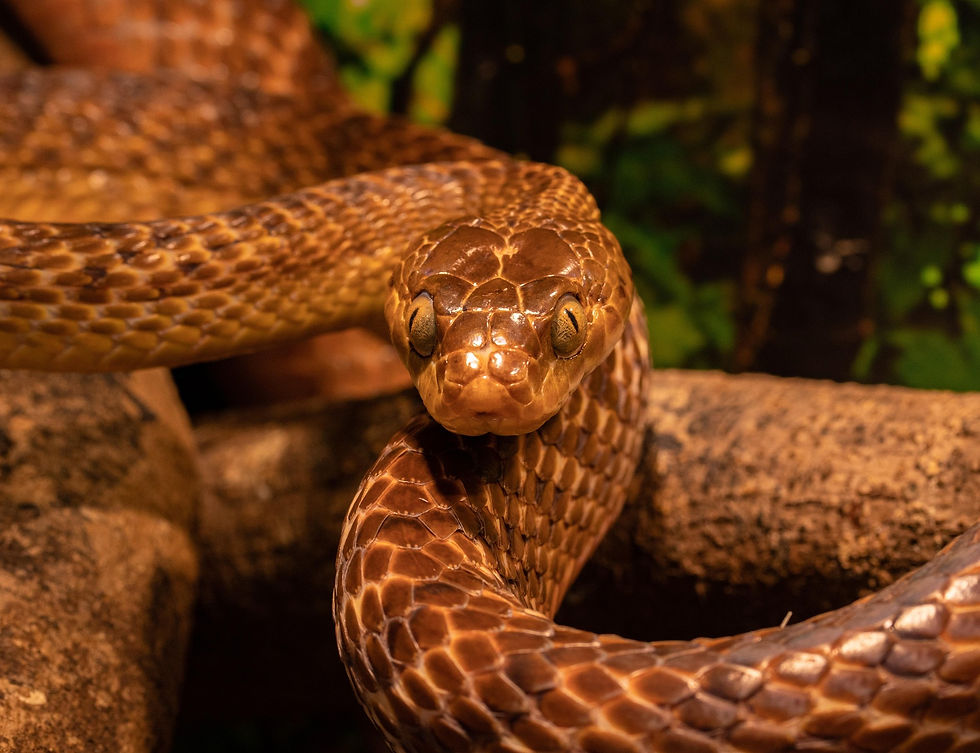The Astonishing World of Flying Snakes: Aerodynamic Serpents of Southeast Asia
- Trader Paul
- Aug 30
- 4 min read

When we think of animals that glide through the air, snakes rarely come to mind. Yet hidden in the forests of Southeast Asia are remarkable reptiles that defy our expectations by launching themselves from treetops and gracefully soaring between branches. Paradise tree snakes and their flying relatives showcase one of nature's most unexpected adaptations, turning their limbless bodies into surprisingly efficient gliding instruments.
Masters of the Aerial Serpent World
Flying snakes belong to the genus Chrysopelea, comprising five species that have evolved an extraordinary ability to glide through forest canopies. Despite their name, these reptiles don't actually fly—they glide with remarkable precision and control. The most accomplished glider among them, the paradise tree snake (Chrysopelea paradisi), can travel horizontal distances of up to 100 feet while losing only modest height.
These slender, brightly colored snakes inhabit tropical forests from India and southern China across Southeast Asia to Indonesia and the Philippines. Typically measuring between 2 and 4 feet in length, they sport vibrant patterns of green, black, and sometimes red or yellow scales that provide excellent camouflage among the leaves and branches of their arboreal homes.
The Science Behind Snake Flight
What makes flying snakes truly fascinating is the innovative way they've adapted their cylindrical bodies for aerial locomotion. When preparing to launch, a flying snake will dangle from a branch, forming a J-shape with its body before propelling itself outward with the lower portion of its body.
Once airborne, the snake performs an extraordinary transformation. It flattens its body by splaying its ribs outward and drawing in its ventral surface, effectively morphing its round cross-section into a concave wing-like structure. This dramatic shape change increases the snake's width by up to twice its normal size while creating a depression along its underside.
The snake doesn't passively fall but actively controls its descent through undulating S-shaped movements. These lateral undulations, similar to how snakes swim, create stability and lift. Research has shown that these aerial serpents can actually make turns mid-glide and adjust their trajectory to reach specific targets.
Surprising Aerodynamic Efficiency
What has puzzled scientists for years is just how efficient these limbless reptiles are at gliding. A 2020 study published in Nature Physics revealed that flying snakes actually generate more lift than would be expected from conventional wing shapes. The snake's unique cross-sectional shape creates vortices of air—swirling patterns that enhance lift by creating low-pressure zones above the snake's body.
Even more remarkable, these snakes achieve their greatest aerodynamic efficiency at angles that would cause traditional wings to stall. While most airfoils perform best at small angles relative to oncoming air, flying snakes maintain lift at much steeper angles, allowing them to glide farther and with more control than their body shape would suggest possible.
Life in the Trees
Flying snakes are diurnal hunters, actively searching for prey during daylight hours. Their diet consists primarily of lizards, frogs, birds, and small mammals that share their arboreal habitat. These snakes are mildly venomous, using their toxin to subdue prey, though their venom poses little danger to humans.
Their gliding adaptation serves multiple purposes. First, it allows efficient movement through the discontinuous forest canopy without having to descend to the ground, where they would be more vulnerable to predators. Second, it provides an escape mechanism when threatened, enabling quick retreats from dangerous situations by simply launching into the air.
Conservation Challenges
Despite their remarkable abilities, flying snakes face increasing challenges. Habitat destruction through deforestation threatens their specialized ecological niche. As tropical forests are cleared for agriculture, logging, and development, these aerial serpents lose the tall trees and connected canopies essential for their unique mode of locomotion.
Climate change poses additional threats, potentially altering the delicate forest ecosystems these specialized reptiles depend upon. Although flying snakes are not currently listed as endangered, continued habitat fragmentation raises concerns about their future population stability.
Inspiring Biomimetic Design
The unusual aerodynamic properties of flying snakes have caught the attention of engineers and roboticists. Their unique gliding technique offers inspiration for designing small-scale flying robots and drones that could maneuver in tight spaces or navigate complex environments.
Scientists at Virginia Tech have created robot models mimicking the cross-sectional shape of gliding snakes to better understand their aerodynamics. This research not only illuminates the evolutionary adaptations of these remarkable reptiles but also suggests novel approaches to human-engineered flight systems designed for specialized purposes like search and rescue operations in dense forests or collapsed buildings.
Conclusion: Nature's Unexpected Aviators
Flying snakes remind us that evolution's solutions often defy our expectations and preconceptions. These remarkable reptiles have transformed what appears to be one of the least flight-adapted body forms—a cylindrical, limbless tube—into an effective gliding apparatus through ingenious anatomical and behavioral adaptations.
The next time you contemplate animals that take to the air, remember that alongside birds, bats, and insects, there exist serpents that have conquered the skies in their own unique way. In the dense forests of Southeast Asia, these extraordinary gliders continue to surprise scientists and challenge our understanding of what's possible in the natural world.
As we learn more about these aerial serpents, they stand as powerful symbols of nature's boundless creativity and the remarkable adaptations that can evolve even in seemingly unlikely candidates for flight.
Comments